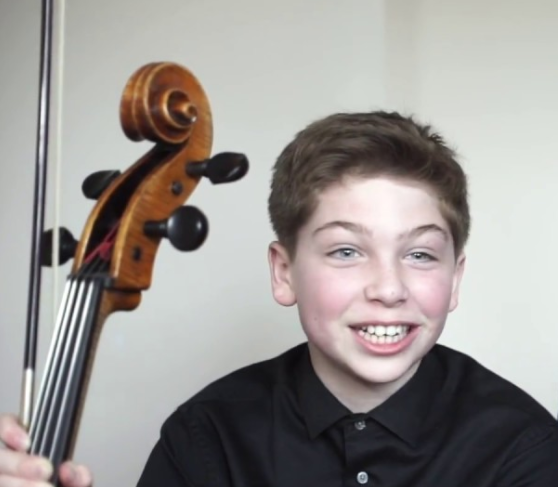Zehavi Rodriguez, cello; New York Chamber Players Orchestra; Giacomo Franci, Artistic Director
Liederkranz Concert Hall, New York, NY
October 13, 2017
Four prizewinning young string soloists had an opportunity last month to be heard with the New York Chamber Players Orchestra as part of their Young Artist Showcase Concert, chosen through NYCP’s Young Artists 7th Annual competition. As stated on the orchestra’s website www.newyorkchamberplayers.org, the competition finals in June were “open to 12 prodigies” with the intent of choosing three winners. Four were ultimately selected to perform October 13th at the lovely Liederkranz Concert Hall off Fifth Avenue.
As I was assigned to review only the cellist among the winners, I will focus on that shortly, but wanted to acknowledge also the other performers, in all cases exceptionally accomplished for their ages. In addition, one should mention that the NYCP Orchestra performed the much-loved Symphony No. 40 in G minor (K. 550) by Mozart as the first part of the program, acquitting themselves well of its challenges, especially for an orchestra that is not a large full-time one. The second part was devoted to soloists with orchestra.
The first soloist was Fourth Prize winner, Chelsea Xia, a violinist, who played Mozart’s Concerto No. 5 in A major (K. 219). She played just the final movement, for which the piece has been nicknamed the “Turkish” on account of its incisive rhythmic section in A minor (resembling the Rondo from the later Piano Sonata in A major K. 331). Ms. Xia played with admirable technical polish for one so young and a good amount of gusto in the jaunty “janissary music” moments. She has a very promising start on what should be a fine career ahead.
Third Prize went to Sara Yamada, violinist, playing Pablo de Sarasate’s Zigeunerweisen, Op. 20 (Gypsy Airs). It is always a striking experience to hear such a youngster (whom one might expect to see playing in the park) performing at such a high level in a Romantic virtuoso style. She played with exceptional technique and assurance. One should be accustomed to such accomplishments by now, with prodigies abounding, but it never fails to jolt one out of one’s seat. Granted, there is room for further growth, but if this is childhood, what amazing things may await!
The First Prize Winner, violinist Joseph Hsia, finished the concert with the Vieuxtemps Concerto No. 5 in A minor, all three movements. The most mature of the players we heard, he appears ready technically to take on any challenges that music offers. He demonstrates the ability to immerse himself fully in a long, involved work and approaches even the perilous spots with the assured kind of bull’s-eye intonation that invites the listener to relax and do the same, without bracing nervously at each Olympic hurdle, as one often does in youth concerts (and even concerts by established professionals). Bravo!
The only cellist of the evening was the winner of Second Prize, Zehavi Rodriguez, also the youngest of the players at just age eleven. He performed the Saint-Saëns Cello Concerto in A minor, Op. 33, with a command and flair belying his youth.
On the subject of age, there was nothing about this cellist’s demeanor that screamed “prodigy” in the stereotypical way – no overdone attire, no precious mannerisms – but rather a no-nonsense attitude about what seemed an earnest pursuit of music. When he walked out to play, there was a mature suavity about him that was matched by some very mature playing. He is a young musician who may well be on his way to some grand achievements.
From his first declamatory phrases to the rapid double-stops, and particularly the more chromatic descending sixths section, he was undaunted. He demonstrated a keen awareness of the shifting drama and lyricism of the piece, and he always reflected a sense of where he fit in with the overall supporting harmony and structure – no small feat for one his age. While one can always find little issues here and there to critique – an isolated intonation glitch, an occasional need for more time or accentuation – there was no question that this young man has the ability to go far in music, should he ultimately desire that.
On a side note about the shortened version chosen, many teachers do have their students make some cuts, though this was perhaps one of the most radically shortened versions heard to date, leaving the piece at just six minutes duration (as opposed to around twenty). It “worked” to put it in practical terms, but one might envision Mr. Saint-Saëns cringing at the radical surgery. This reviewer (in the role of accompanist) recalls flipping through the chaos of omitted pages of a piano reduction of it decades ago in the studio of a famed cello teacher, having learnt the harsh lesson that “that is how everyone does it.” To fit something of the piece into a showcase concert or a competition time limit, yes, one can understand dispensing with the more “meandering” parts – and for an eleven-year old, even six measures of this piece can provide ample challenge! – but down the road one hopes to hear this young man in unaltered repertoire.
In any case, all flowed fairly seamlessly to an exciting conclusion. Mr. Rodriguez handled the final build-up with just the right bit of swagger in the syncopated passages, and there was joyous momentum towards the exciting finish. Even the most jaded reviewer has to admit that there is little that is more exciting than hearing a young musician’s first concerto appearance with orchestra.
All in all, the evening was a resounding success. Hats off to the NYCP Orchestra for pulling off such a worthy endeavor!

